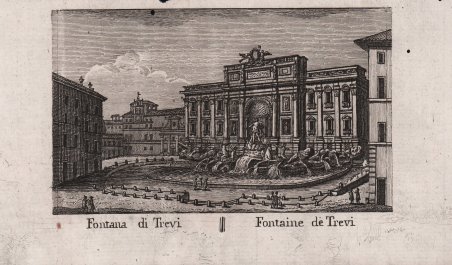Galatea attraversa l'acqua con il suo carro di conchiglie trainato da due delfini, circondato da Tritoni e Nereidi. Bulino, 1592, datato e firmato in basso sul margine in tre colonne, ogni due righe "Nerine spumante . vivere gaudet" di "F. Estius". In basso "Opus hoc depictam est suis coloribus Rome ad parietem per Raphaelemm D'Urbin, in palatio Augustini Ghigi, et ibidem ab HGoltzio adnotatum, / et deinde eri in insculptum. Anno. 1592". Deriva dall'affresco di Raffaello nella villa di Agostino Chigi (oggi Villa Farnesina). L'affresco il Trionfo di Galatea, che Raffaello Sanzio vede commissionato dal potente banchiere Agostino Chigi per la sua nuova villa romana, resta tutt'oggi uno dei suoi capolavori assoluti. Il dipinto è pensato per dialogare con altri affreschi vicini, tuttavia, ha un po' il sapore dell'"incompiuto", poiché racconta solo una parte del mito della ninfa innamorata del bel pastore Aci e contesa da Polifemo. Raffaello Sanzio si dedica all'affresco detto il Trionfo di Galatea nei primi decenni del’500. A Villa Farnesina l'opera si trova in una lunetta, tra due dipinti di Sebastiano del Piombo: nel progetto iniziale, con ogni probabilità, dovevano essere affrescate da Raffaello altre scene della leggenda di Galatea; invece, furono descritti solo gli eventi principali. Secondo quanto riportato da Baldassarre Castiglione, Raffaello dipinse la bellissima ninfa a sua idea, senza che nessuna modella posasse per lui. Nel mondo rinascimentale ricco di allegorie, il Trionfo di Galatea ha un significato legato al mito: Galatea è una delle figlie di Nereo e Doride, quindi una delle cinquanta ninfe del mare dette Nereidi. Innamorata di Aci, Galatea suscita l'invidia di Polifemo, a sua volta innamorato di lei: quando quest'ultimo vede la fiamma di Galatea insieme a lei, accecato dalla gelosia scaglia contro Aci un masso di lava, uccidendolo. Zeus, scorgendo Galatea piangere tutte le lacrime che ha sul corpo del povero ragazzo, decide di trasformare il sangue del defunto in un fiume, individuabile in Sicilia, che sgorga dall'Etna e la cui sorgiva ha un colore tendente al rosso, per la presenza in loco di ossidi di ferro. Magnifica prova, ricca di toni, impressa su carta vergata coeva, rifilata al margine, controfondata al verso su carta “japon”, restauri conservativi nella parte inferiore e nell’angolo superiore destro perfettamente eseguiti, per il resto in buono stato di conservazione. Bibliografia The New Hollstein: Dutch and Flemish etchings, engravings and woodcuts 1450-1700 n. 334; Hollstein / Dutch and Flemish etchings, engravings and woodcuts c.1450-1700 n. 313; Hirschmann 1921 / Hendrik Goltzius, Verzeichnis des graphischen Werkes n. 313; Strauss 1977 / Hendrik Goltzius: the complete engravings and woodcuts n. 288; Bartsch / Le Peintre graveur III.82.270; H. Leeflang, G.Luijten, 'Hendrick Goltzius (1558-1617): Drawings, prints and paintings', Rijksmuseum, Amsterdam, Metropolitan Museum of Art, New York and Toledo Museum of Art, Ohio, ex. cat. 2003, n. 45. Galatea drives across the water in her chariot of a shell drawn by two dolphins, surrounded by Tritons and Nereids, after Raphael. Engraving, 1592, dated and signed at the bottom. Lettered in the margin in three columns, each two lines "Nerine spumante . vivere gaudet" by "F. Estius". Below "Opus hoc depictam est suis coloribus Rome ad parietem per Raphaelemm D'Urbin, in palatio Augustini Ghigi, et ibidem ab HGoltzio adnotatum, / et deinde eri in insculptum. Anno. 1592". After Raphael's fresco in the villa of Agostino Chigi (now the Villa Farnesina). The fresco the Triumph of Galatea, which Raphael Sanzio saw commissioned by the powerful banker Agostino Chigi for his new Roman villa, remains to this day one of his absolute masterpieces. The painting is meant to dialogue with other nearby frescoes, however, it has a bit of the flavor of "unfinished," as it tells only part of the myth of the nymph in love with the handsome shepherd Aci and contended by Polyphemus. Raphael Sanzio devoted himself to the fresco known as the Triumph of Galatea in the early decades of the'500s. At the Villa Farnesina the work is located in a lunette, between two paintings by Sebastiano del Piombo: in the initial project, in all probability, more scenes of the legend of Galatea were to be frescoed by Raphael, instead only the main events were described. According to Baldassarre Castiglione's account, Raphael painted the beautiful nymph at his own idea, without any models posing for him. In the allegory-rich Renaissance world, the Triumph of Galatea has a meaning related to myth: Galatea is one of the daughters of Nereus and Doris, thus one of the fifty sea nymphs known as Nereids. In love with Acis, Galatea arouses the envy of Polyphemus, who is in turn in love with her: when the latter sees Galatea's flame together with her, blinded by jealousy he hurls a boulder of lava at Acis, killing him. Zeus, spotting Galatea weeping all the tears she has over the poor boy's body, decides to transform the blood of the deceased into a river, identifiable in Sicily, which flows from Mount Etna and whose spring has a color tending to red, due to the presence there of iron oxides. Magnificent proof, richly toned, printed on contemporary laid paper, trimmed at margin, laid down on "japon" paper, restorations at bottom and upper right corner perfectly executed, otherwise in good condition. ' Bibliografia The New Hollstein: Dutch and Flemish etchings, engravings and woodcuts 1450-1700 n. 334; Hollstein / Dutch and Flemish etchings, engravings and woodcuts c.1450-1700 n. 313; Hirschmann 1921 / Hendrik Goltzius, Verzeichnis des graphischen Werkes n. 313; Strauss 1977 / Hendrik Goltzius: the complete engravings and woodcuts n. 288; Bartsch / Le Peintre graveur III.82.270; H. Leeflang, G.Luijten, 'Hendrick Goltzius (1558-1617): Drawings, prints and paintings', Rijksmuseum, Amsterdam, Metropolitan Museum of Art, New York and Toledo Museum of Art, Ohio, ex. cat. 2003, n. 45. Cfr.


Find out how to use
Find out how to use

